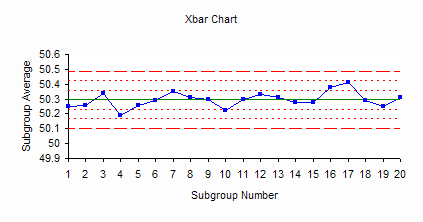
We conclude that the process is in control. In both charts, there are not any data points failing any tests for special causes (i.e., all the data points fall between the control limits and spread around the center line with a random pattern). Model summary: Since the R chart is in control, the Xbar chart is valid. The Xbar-Rcharts appear in the newly-generated window.Click “OK” in the window “Xbar-RChart – Options.”.Select the item “Perform all tests for special causes” in the dropdown menu.Click “Xbar-ROptions” button and a new window “Xbar-R Chart – Options” appears.Select the “Subgroup ID” as the “Subgroup size (enter a number or ID column).Select the “Measurement” into the box below “All observations for a chart are in one column.”.Click in the blank box right below “All observations for a chart are in one column” and the variables appear in the list box on the left. The X-bar helps to monitor the average or the mean of the process and how this changed over time.

A new window named “Xbar-RChart” appears.Click Stat → Control Charts → Variable Charts for Subgroups → Xbar-R.D3 and D4 are constants depending on the subgroup sizeĭata File: “Xbar-R” tab in “Sample Data.xlsx”.m is the subgroup size and k is the number of subgroups.Xbar Chart EquationsĪ2 is a constant depending on the subgroup size.

The underlying distribution of the Xbar-R chart is normal distribution. The Xbar is valid only if the R chart is in control. The Xbar chart monitors the process mean and the R chart monitors the variation within subgroups. The R chart plots the difference between the highest and lowest values within a subgroup as a data point.The Xbar chart plots the average of a subgroup as a data point.
#XBAR R CHART HOW TO#
The following PDF describes X-Bar/R charts and shows you how to create them in R and interpret the results, and uses the fantastic qcc package that was developed by Luca Scrucca. The Xbar R chart is a control chart for continuous data with a constant subgroup size between two and ten. There are many different flavors of control charts, but if data are readily available, the X-Bar/R approach is often used.


 0 kommentar(er)
0 kommentar(er)
